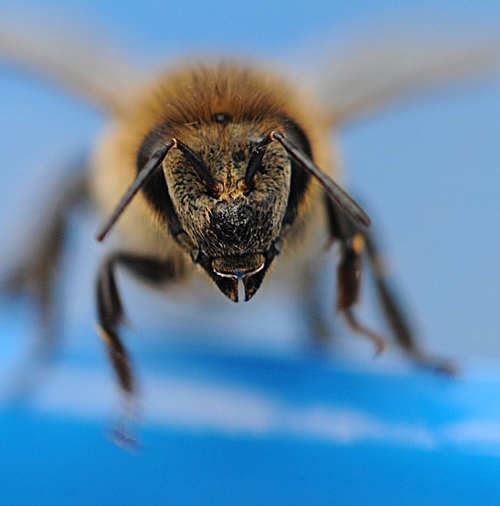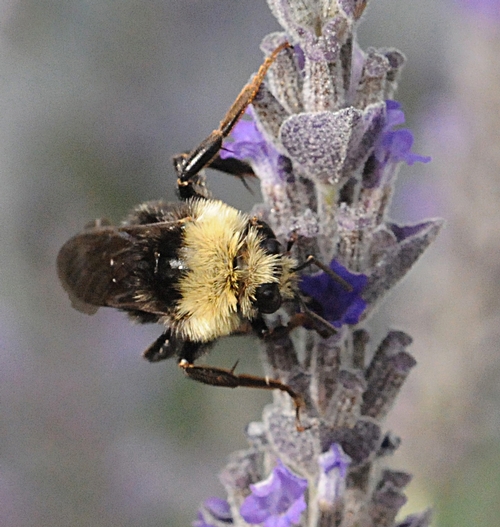- Author: Kathy Keatley Garvey
It's raining bumble bees in our pool.
Yellow-faced bumble bees (Bombus vosnesenskii).
And honey bees (Apis mellifera), too.
While nectaring lavender, catmint, tower of jewels, sedum and other plants, some of the foragers land in our pool. Talk about no depth perception.
We fish them out and most survive. (A floating piece of styrofoam now provides them with a little protection from the untimely dips.)
For the two below, it was definitely a bad hair day.


- Author: Kathy Keatley Garvey
Those yellow-faced bumble bees know how to put on a happy face.
The males and females frequent our bee friendly garden to sip the sweet nectar of lavender, catmint and rock purslane. The females collect both nectar and pollen for their brood.
I think we have a nest of them beneath the catmint.
Plant it, and they will come.
The yellow-faced bumble bee (Bombus vosnesenskii), as its name implies, has a yellow face, a mostly black thorax and abdomen, and a yellow band near the tip of its abdomen.
The ones below are males, according to native pollinator specialist and noted bumble bee expert Robbin Thorp, emeritus professor of entomology at the University of California, Davis. Although officially "retired" (not!), he continues to do research on bumble bees and other pollinators.
Thorp also monitors the half-acre Häagen-Dazs Honey Bee Haven at the Harry H. Laidlaw Jr. Honey Bee Research Facility at UC Davis for bee species.
It's a treat to see the bumble bees there.
It's a treat to see them anywhere.
You gotta love those bumble bees.




- Author: Kathy Keatley Garvey
It's time to pop open a bottle of champagne and do a happy dance.
Finally, finally, we saw a yellow-faced bumble bee (Bombus vosnesenskii) in our yard.
After a 20-year absence.
Dusted with yellow pollen, it (or rather he) was nectaring the rock purslane--he, along with assorted honey bees and hover flies.
This Bombus brought to mind the May 27th Webinar that bumble bee expert Robbin Thorp, emeritus professor of entomology at UC Davis presented on "The Plight of the Bumble Bees" at UC Davis.
At the Webinar, he focused on Franklin's bumble bee (range of southern Oregon and northern California) and now feared extinct.
Thorp, a fellow of the California Academy of Sciences since 1986, is a noted authority on bumble bees. In June he served as a key speaker at a public symposium on "The Plight of the Bumble Bees" at the Smithsonian Institution, Washington, D.C. His topic: "Western Bumble Bees in Peril."
Thorp's Webinar he gave at UC Davis is a must-see, must-watch. You'll also want to check out the bumble bee work of Thorp and other scientists on the Xerces Society Web site.
Bumble bees need our protection.
As Thorp says: "“The loss of a native pollinator could strike a devastating blow to the ecosystem, economy and food supply."



- Author: Kathy Keatley Garvey
Thar’s gold in them thar hills.
And also bumble bees.
If you visit the Sonoma County coastal town of Bodega Bay, and drive up to Bodega Head overlooking the ocean, you’ll see a carpet of gold flowers known as coastal goldfields or Lasthenia minor.
And you’re certain to see bumble bees nectaring those flowers.
Noted bumble bee expert Robbin Thorp, emeritus professor at UC Davis, says the most common species of bumble bee at Bodega is the yellow face bumble bee, Bombus vosnesenskii. The second most common? Bombus bifarius.
Goldfields are natives and so are bumble bees. Goldfields belong to the Asteraceae family, also known as the aster, daisy or sunflower family.
Want to learn more about bumble bees? Bumble bees are very much in the news. Thorp wrote a piece for a UC Berkeley publication. He recently addressed the Smithsonian Institute on the plight of the Western bumble bees and gave a Webinar at the UC Davis Department of Entomology on Franklin's bumble bee, an insect he fears may be extinct.
Gordon Frankie, Robbin Thorp and colleagues also wrote the lead story on native bees, featured in the latest edition of California Agriculture.
It's good to see the plight of the bumble bees drawing so much interest and it's good to see all the bumble bees at Bodega Bay.
BB at BB.



- Author: Kathy Keatley Garvey
The Smithsonian Institution is the place to "bee" on Monday, June 22.
UC Davis pollinator specialist and researcher Robbin Thorp will join other bumble bee experts from across the country in a "Plight of the Bumble Bees" public symposium from 10 a.m. to 12:30
The location: Baird Auditorium, National Museum of Natural History. The Smithsonian is located at the corner of 10th Street and Constitution Avenue NW, Washington D.C.
Thorp will discuss "Western Bumble Bees in Peril." Sydney Cameron and Jeff Lozier of the University of Illinois will examine "The Status and Trends of Midwestern and Southern Bumble Bees." Then Leif Richardson of the Vermont Department of Fish and Wildlife will cover "Bumble Bee Trends in Northeastern North America."
Other speakers:
- Stephen Buchmann, University of Arizona, "USA Native Bee Diversity: Rarity, Threats and Conservation Ideals"
- Paul Williams, Natural History Museum, London, "A Global View of Bumble Bees and Their Conservation Status."
Michael Ruggiero of the Smithsonian Institution will moderate. He's the senior science advisor of the Smithsonian's Integrated Taxonomic System (ITIS).
Following the symposium, bumble bee experts and other scientists will continue to meet at the Smithsonian for the next two and a half days to discuss concerns about the declining bumble bee population.
The symposium is part of National Pollinator Week, which starts Monday, June 22 and continues through Sunday, June 28.
Thorp delivered a presentation on Franklin's bumble bee May 27, during one of the UC Davis Department of Entomology's noonhour sessions. Franklin's bumble bee, feared extinct or nearing extinction, is found only in one part of the world: southern Oregon and northern California. Thorp's talk was Webcast.
Thorp, a member of the California Academy of Sciences since 1986, says that the loss of a native pollinator "could strike a devasting blow to the ecosystem, economy and food supply."
Locally, we've noticed far fewer bumble bees than in past years. Last summer we spotted a few in the UC Davis Arboretum (see below). This is the yellow-faced bumble bee or Bombus vosnesenskii, the most common Califonria bumble bee.
Not so common any more.





